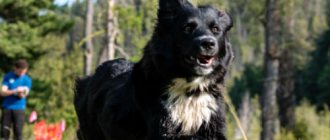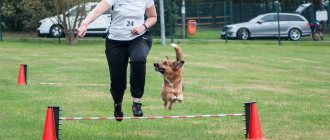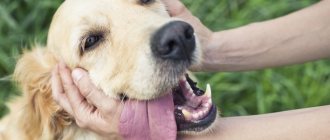Team "Somersault"
Roll is a very fun command to teach your dog. Before you begin, your dog should already be able to sit and lie down on command. Teaching your pet to roll over will be a little more difficult than teaching it some other commands. This is because there are several parts to this trick. But with a little patience, your dog will succeed.
How to teach your dog the somersault trick
Make sure you have a tasty treat before you start. A clicker is also necessary if you use it for training. Practice the trick on a comfortable, soft surface so that your dog is comfortable following the command. For example, it could be grass or sand.
Training in several stages
It will be great if your dog does the somersault right away. However, most dogs don't roll over after the treat on the first try. The pet may jump up, roll on its back, or turn its head in a completely different direction to try to eat the treat. If the same thing happens to your dog, then try dividing the training into smaller stages.
How to teach somersault
Some animals are wary of any movements involving a flip, so before learning the command itself, you need to prepare for it. There is an easy-to-learn technique for this, consisting of several steps:
- the four-legged friend is laid on the floor and squatted next to him;
- with the right hand they bring the treat to the muzzle so that the pet becomes interested in it;
- slowly move the palm along the left side to the tail, while making sure that the animal also reaches with its head for the treat.
This is the first stage of learning to roll over. When the animal boldly turns its head towards the tail, the movement is made more difficult. For different dogs, the rotation point is at different levels, so they act in one of the suggested ways:
- the treat is brought behind the animal’s back through the croup;
- the treat is led over the shoulder back towards the shoulder blades.
Sooner or later the animal will fall over on its side and you can finish learning the complex trick. Again, make sure that the pet’s head follows the treat:
- the movement of the hand continues backwards until it turns onto the back;
- then the tasty treat is placed under the chest between the front paws;
- As a result, the watchdog ends up on his stomach again.
Now you can work according to the well-known scheme.
A little theory
What does the "Somersault" command mean?
At the command or gesture of the owner, the animal must turn from a lying position around its axis through its side (right or left), once again finding itself in its original position. To develop the skill, a reward method is used: any treat that is not part of the pet’s regular diet. This could be biscuits, a piece of cheese, ham, or a ready-made treat that is sold in any pet store today.
It is important to exercise on an empty stomach so that the animal willingly and enthusiastically performs the exercise proposed by the trainer. During one lesson you should not study for more than 10-15 minutes. It is best to alternate commands so that the dog does not get tired of the monotony, and the brain is in active work all the time.
Before starting the study, the pet must be able to perform other commands: “Stand”, “Lie down”, etc.
The initial skill is developed in a calm environment, where there are no distracting stimuli. It is best to teach your dog the “Turl” command at home in a spacious room on a warm floor. In the future, you can work outside, but the requirements for the surface remain the same:
Execution options
After the dog has learned to perform the classic somersault well, the command can be slightly more complicated.
- Practice executing the command in different directions. To do this, you can enter the additional command “Ride”. A turn in one direction is indicated by the command “Turl”, and in the other direction by the command “Roll”.
- Teach the dog to teach the command not only in the position in front of the dog, but also near the owner's leg.
- Practice the “Turl” and “Skate” commands at a distance.
- Teach your pet to roll up in a blanket using this command. Give your pet a piece of blanket in his teeth, then say the command “Tumble.” If the dog is not completely wrapped up, you can add the “Roll” command.
When training a command, it is necessary to ensure that the dog works cheerfully and joyfully. The pleasure you get from your activities is a very important part of success. If training brings joy to both the dog and the owner, you will be able to learn the “Turl” command quickly and without problems!
Share the link with your friends:
Found a mistake? Let us know about it!
Operating rules
You can teach a dog the “Turl” command only after practicing the “Lie down” order. An approximate training scheme is as follows.
At the beginning of classes, rewards are given for each correctly completed order. Over time, giving treats is eliminated, otherwise the animal will subsequently refuse to work without food.
They practice until the dog begins to carry out the command without the help of a trainer, only by one gesture or voice command. Afterwards, you can move on to complicating the skill - teaching the dog to turn around on the other side.
They work according to the same scheme, only the usual “Turl” command is replaced with an alternative one, for example “Roll” or “Roll”. This is necessary so that the watchdog clearly knows which direction he needs to turn over now.
Sharpening Your Abilities
Complicating the skill is the partial exclusion of food reward. For this:
- stop giving food after each command;
- increase the gap between the giving of food and the actions taken;
- treats are changed periodically so that the animal has an incentive to work and is interested in it;
- if a treat is not given, then the pet must be praised verbally - any approval from the owner is important for him.
Next, they go outside to practice. Again, they are looking for a deserted area where the dog often visits, so that it does not have to take a long time to adapt to the new place. Over time, tricks can be performed in other, busier, noisier places in the presence of strangers. It is important to move gradually and slowly from one stage to another.
Tips from dog handlers
Recommendations for training:
- Dividing the course into stages (teams study separately).
- Lack of rudeness on the part of the owner (even if the animal refuses to follow orders).
- Individual approach for each pet.
- The maximum duration of one lesson is 60 minutes.
- Preparing the necessary items in advance (collar, leash, treats for gratitude);
- Choosing a deserted area for conducting classes. An important condition, failure to comply with which can lead to serious consequences.
- Distraction from extraneous environmental factors.
- The pet must be given the opportunity to sniff the area before training (the belief that there is no danger allows the dogs to concentrate on following orders).
- The right choice of treats (using dry food so as not to stain the animal and the owner’s clothes).
Showing persistence and patience is the key to teaching an animal the necessary skills. After completing a training course, the animal becomes well-mannered and socially harmless to the people around it.
Minor
Give me your paw
Training algorithm:
- The owner sits the dog next to him.
- Calling a pet by name, pronouncing the order “Give me your paw!”
- Pointing to paw and showing goodies.
- Taking a four-legged paw in your hands.
- Repeat command again.
- Rewarding with a treat.
The command is easy to learn at home.
Voice
The skill is necessary for hunting breeds.
Recommendations for training:
- Tying the animal to a tree, then step on the leash.
- Pronunciation of the command “Voice!”, demonstration of treats.
- Rewarding your pet after completing an order.
- Repeat the exercise several times.
Aport
What commands can be taught to a puppy worries many owners. The “fetch” order is easy to study at home. The point of the exercise: the puppy returns an item abandoned by the owner. The next stage is for the animal to sit next to the owner and wait for further instructions.
- Search for a stick or bone.
- Teasing an animal for a short period of time.
- Throwing things, pronouncing the command “Fetch!”
- Praise and treats.
- Repeat for 3-5 times.
Place
You can train your pet at any age. The execution is simple: luring the dog to the right place, pronouncing the command “Place!” The next stage is rewarding with treats. For a long stay of the animal in the right place, you can throw the four-legged toy there.
"Standard" tricks
Give me your paw:
• Clamp the treat in your fist and hand it to the dog. • We wait for the pet to hit his hand with his paw. • We hold the paw and clearly give the command. • We praise.
After mastering the technique, the dog can be taught to give the left or right paw.
Hands up. The dog sits in a column and raises its front paws to the level of its muzzle. Teaching technique:
- We sit the dog down.
- Using treats, we lift the pet into a column and hold it if necessary.
- We tease the dog with a treat until he raises his paws and clearly pronounce the command.
- We praise.
Voice. The dog barks on command. Two teaching techniques:
- We tease the dog with treats until he barks, give the command and praise.
- If you know your dog's body language well, give the command before he barks and reward him after.
Quiet. The dog stops barking on command. The training is similar, we praise the dog when it stops barking. To stop the dog barking instantly, you can distract it with a toy, game or treat.
Dance moves
Freestyle is the official name for trick training. The essence is a dance that the dog and handler perform in sync. Some dance elements are very simple, they can be practiced without having a “dance” base.
Bow. The dog extends its front legs and takes a reclining position. Teaching technique:
- We hold the dog under the croup.
- Using treats, we lure the dog forward and down.
- When the pet stretches out, we clearly pronounce the command and praise it.
Back. The dog walks backwards next to or between the owner's legs. Quite a difficult trick to perform. Teaching technique:
- We put the dog nearby.
- We hold the treat above our heads and slowly move backwards.
- We praise when the dog takes a few steps.
It is important not to bring the treat too far behind the head, otherwise the dog will obey the “Sit” command. To prevent sitting down, the pet can be held under the belly.
Twist. Circular movement in front of the owner. Two teaching techniques:
- We give a command and lure the dog with a treat, provoking it to turn around its axis.
- We give the command and, using a toy on a rope and a handle, we force the dog to spin.
Support. The dog walks on its hind legs, leaning on a cane (umbrella). For training, it is enough to let your pet understand that leaning on a support is safe and comfortable. It is important to hold the cane firmly to prevent the dog from losing its balance.
Crawl. An additional and trick command, according to which the dog moves in a lying position. Teaching technique:
- We put the pet down.
- Using a treat or a toy, we entice the dog to crawl.
- To prevent the dog from getting up, we carefully hold it by the withers or croup.
- We praise you generously.
After the initial mastery of the command, the dog can be taught to crawl under special equipment or obstacles.
Somersault. The dog rolls onto the other side in a lying position. Teaching technique:
- We put the dog to bed.
- We raise the hand with the treat behind the head, through the shoulder blades.
- When the pet reaches for a treat, we push it a little, roll it to the side and help it roll over.
Snake (slalom). The dog runs in a zigzag between the legs of the walking owner or through a special obstacle. Training techniques are similar - the dog needs to be slowly led between the bars or legs, using a treat or toy. Be sure to give the command before the execution begins, since when performing the “Snake” on its own, the dog must have time to evaluate the speed of the owner’s step.
"Household" tricks
I'm tired. Each time before stopping activity, you should yawn or do stretches. Over the course of a week, the dog will learn this “sign” and will repeat it if it is tired, for example, during training.
Bring your ball /bear/other toy:
- Choose a toy and call it only one name.
- Repeat constantly: “this is your ball”, “take the ball”, “carry the ball”.
- After 3-4 days, place the selected toy next to other objects and ask the dog: “Fetch your ball.”
- If necessary, point to the desired object with your palm.
- Praise your dog generously if successful.
Good night. A trick almost similar to the "Place" command. The convenience is that the dog clearly understands that it is time to sleep, and not to “sit out” on the lounger for a while.











